What more important natural resource could there be than the air we breathe every minute of every day? And yet, air pollution remains rampant throughout the world. The World Health Organization has estimated that air pollution causes seven million deaths per year from problems such as heart disease, respiratory ailments, and cancer. Major sources of air pollution include mobile sources like cars and trucks and stationary sources like factories and power plants. Relatively minor sources range from cigarettes and hairspray to volcanoes and cow farts.
When it comes to our air, the biggest hazard posed by religion is that religious people really like burning stuff. Whether they are burning incense or firecrackers or logs or paper or pieces of cardboard put together to resemble a small house, religious believers around the globe can’t seem to get enough of using fire to celebrate their traditions.

When God Isn’t Green: A World-Wide Journey to Places Where Religious Practice and Environmentalism Collide
Jay Wexler
Beacon Press
March 15, 2016
According to news reports, there are so many bonfires lit on Lag B’Omer that satellite images reveal a smoky haze hovering over Israel during the holiday. Scientific research has shown that visits to emergency rooms for asthma and chronic obstructive pulmonary disease (COPD) occurrences go way up because of the smoke, which is hardly surprising since the concentration of particulate matter on the evening of the holiday can spike to as much as ten times the normal level. Government officials in Israel are well aware of the problem. A study authorized by the Knesset showed that the bonfires contribute to the problem of global warming, and that body has recommended (though not required) that people refrain from lighting them. The message has not been well received in most quarters. When an influential local mayor launched a campaign to convince residents to find alternative methods of celebrating the holiday, the people became outraged. As one journalist wrote: “In an instant, the popular mayor became the local killjoy, the Grinch who was trying to steal Lag B’Omer. The local press and town Internet forum erupted with residents blasting [the mayor] for his attempt to extinguish the flames. ‘Next thing you know he’ll be ordering us not to light Hanukkah candles,’ one angry resident wrote.” In fact, Hanukkah candles do contain hazardous substances like toluene, benzene, and formaldehyde, so it wouldn’t be entirely shocking if somebody did try to ban them.
Beyond bonfires, the burning of incense is a fairly long-standing and ubiquitous religious practice found in all sorts of traditions, including Christianity, Hinduism, and Buddhism. Although incense can be sweet-smelling and pleasant, it is also really dangerous. For whatever reason (the smell, the context, the different treatment by the media, the extreme irrationality of all human beings), people who would go miles out of their way to avoid breathing in the smoke from a single cigarette often have no problem hanging out for hours at a temple or church where the air is filled with billowing plumes of hazardous incense smoke.
When I was visiting Hong Kong, I spent an hour or so at the School of Public Health at the Chinese University of Hong Kong, talking to a research scientist named Kin-Fai Ho, whose work focuses on the effects of toxic air pollutants on human health. Professor Ho was part of a team of scientists who were granted rare access inside of two temples in Hong Kong so they could study the effects of incense burning on the air quality. The team found that during peak times, when incense was being burnt in high quantities, the air was far more polluted than during nonpeak times. At one of the temples, for instance, the peak carbon-monoxide level was three times the nonpeak level, and the average benzene concentration was almost eight times more than the government’s recommendation for public places. When I asked Dr. Ho how incense smoke compares with cigarette smoke, he said the two were comparable with respect to particulate matter, carbon monoxide, and polycyclic hydrocarbons.
Temples and the people visiting them have several alternatives that can help reduce the risk from incense smoke. In their paper, Ho and his coauthors write that “visitors may decrease the number of incense sticks burned and period of stay at temples.” In my travels, I did visit temples that tried to suggest limits on how many incense sticks people should burn. Some temples have tried to deal with this problem by extinguishing incense sticks after they have been burning for a while. Particularly in Hong Kong, I sometimes saw large buckets of water standing near places where large amounts of incense were being burnt, and every once in a while, a temple worker would grab a bunch of sticks and douse them in the water. There is one suggested possible solution, however, that Dr. Ho was not very optimistic about. So-called environmentally friendly incense, which is marketed in some places as a way of reducing the environmental and health impacts of incense burning, turns out, according to a new study that Ho was working on, to have slightly fewer particulate matter emissions but little effect on the amount of toxic pollutants emitted. On my way out of the interview, looking in that journalistic way for the bottom line, I asked Dr. Ho whether he thought incense-smoke inhalation was a problem. He looked at me and responded calmly, “Yeah, it’s a big problem.”
Another problem is fireworks. As someone who has always hated fireworks and would rather stay inside with my head under a pillow than endure a loud, smoky Fourth of July celebration with ten thousand people staring at the sky and going “ooooh” and “ahhh” over and over for half an hour, I find it hard to understand the appeal. But still, people love watching fireworks! Every celebration these days, from the biggest national holiday to the most insignificant home-run hit by a last-place baseball team down 14–0 in the bottom of the eighth inning, seems to be marked by a blast of colorful explosions. Religious celebrations are no exception. Chinese New Year celebrations, which for some take on a religious meaning (many believe the fireworks ward off evil spirits); the Muslim holiday of Eid, which marks the end of the Ramadan fasting period; the Hindu festival of lights known as Diwali; and many other religious holidays and festivals around the world are celebrated with the abundant lighting of firecrackers and fireworks.
Unfortunately, for those of us who need to breathe air in order to live, the smoke produced by fireworks can be quite dangerous. According to one academic paper that showed the effects of fireworks on air pollution during Diwali in India, “fireworks contain harmful chemicals such as potassium nitrate, carbon and sulphur apart from an array of chemicals such as strontium, barium, sodium, titanium, zirconium, magnesium alloys, copper and aluminum powder to create the colourful effects. On burning they release gases such as carbon monoxide and nitrogen dioxide.” The study concluded that fireworks contributed to excessive ozone pollution spikes during the holiday, and that “high ozone levels combined with pollution due to fireworks might be critical for elderly people and children with heart and respiratory ailments.” Another Indian expert similarly concluded, “Gaseous air pollutants along with other toxic gases emitted due to burning of firecrackers aggravates the chance of attack among asthma patients. The patients with heart disease, chronic bronchitis and low immune system are also at high risk.”
The realization that fireworks significantly raise air pollution levels has led officials in Beijing to call for a reduction in the use of pyrotechnics during the Chinese New Year period, and it’s one reason, among others, that Abu Dhabi police have warned Eid celebrants not to use illegal fireworks in the United Arab Emirates. Even in the United States, some critics have called for the federal government to regulate fireworks, rather than exempting them from the ambit of the Clean Air Act. The EPA has refused, claiming that “Congress did not intend to require EPA to consider air-quality violations associated with such cultural traditions in regulatory determinations.”
Although most people probably conjure up images of a dark and smoggy sky when they think about air pollution, in fact indoor air pollution may be nearly as dangerous as outdoor pollution, particularly in developing countries where people routinely burn coal and biomass fuel for cooking and heating their homes. Indoor air pollution also provides the context for one of the most bizarre examples of a religious practice that has created environmental problems in the United States.
Mercury is an element that people generally do not want to mess with. Touching it, eating it, or, most dangerously, breathing in the vapors that it releases can be extremely dangerous, potentially causing respiratory problems and damage to the nervous system. Given the perils of inhaling mercury vapors, it might be surprising to learn that some religious believers actually sprinkle the silver liquid metal inside their homes to ward off evil spirits. The practice puts not only current residents at risk but also future ones, as mercury can remain in fabrics and carpets for up to a decade, releasing dangerous vapors the entire time.
Back in 1989, a middle school chemistry teacher in Brooklyn named Arnold Wendroff was teaching his students about the periodic table. When he asked his students if they knew what mercury was used for, he fully expected someone to mention thermometers. Instead, one of his students answered that his mother, a Santeria practitioner originally from Puerto Rico, liked to sprinkle it around their apartment to fend off witches. Witches? Concerned and curious, Wendroff soon became a one-man watchdog of the ritualistic use of mercury. He learned that many practitioners of Caribbean religions like Santeria, Palo, and Voodoo believe that mercury can bring good luck and keep evil spirits at bay. In large US cities with substantial populations of these believers, practitioners purchase capsules containing a small amount of liquid mercury from so-called botanicas, which are essentially stores that sell religious paraphernalia.
The practitioners then do things like sprinkle the mercury on floors, furniture, or car interiors, or mop the floor with it, or burn it in candles, or mix it with perfume, or even swallow it. Because mercury vapors are so dangerous to inhale and because the mercury remains in the environment for so long, Wendroff concluded that the ritualistic use of mercury posed a significant health hazard that the government needed to address.
Through Wendroff’s efforts, the EPA became aware of the problem in the early 1990s and started considering whether to do anything about it. The agency has several statutes that it could have used to regulate the ritual use of mercury inside homes, most importantly the Toxic Substances Control Act, or TSCA, which allows the agency to take a wide variety of regulatory actions against substances that pose an unreasonable risk to the environment or public health. To look into the issue, the EPA established a task force that conducted research and interviewed interested parties. Ultimately, though, the agency decided against using the TSCA, opting instead to work together with states and municipalities to spread the word about the dangers of mercury through education and community outreach.
In the wake of the task force’s decision, Wendroff continued to call for further efforts to address the indoor religious mercury problem, talking to the media, writing papers in scientific journals, and interacting with various governmental units. In 2005, he asked the Office of the Inspector General at EPA to “determine whether EPA had adequately investigated whether [indoor religious mercury] contamination poses an environmental health threat and, if so, had EPA substantively acted to address its dangers.” Unsurprisingly, the OIG concluded that EPA had acted properly and recommended no further action. On the other hand, the office did release a report on its investigation “to further emphasize that the ritual use of mercury poses a health risk.” This final conclusion does seem to be accurate. A 2011 article in the New York Times, for instance, reported on the case of a three-year-old who suffered mercury poisoning when her family moved into a Rhode Island apartment that had been the site of ritual mercury use by a former tenant many years earlier.
###
Excerpted from When God Isn’t Green: A World-Wide Journey to Places Where Religious Practice and Environmentalism Collide by Jay Wexler (Beacon Press, 2016). Reprinted with Permission from Beacon Press.





